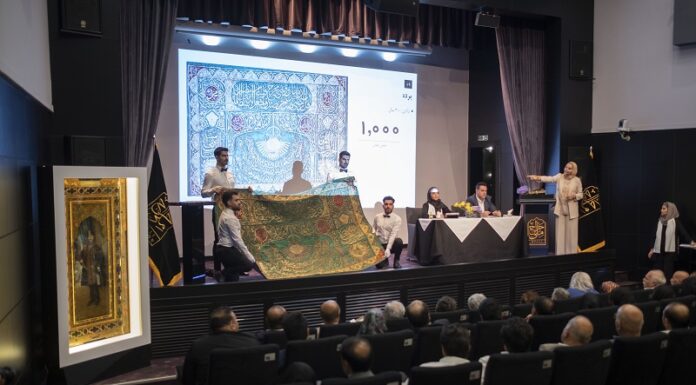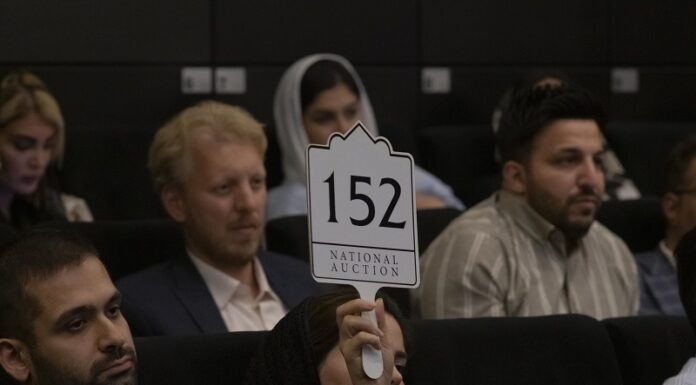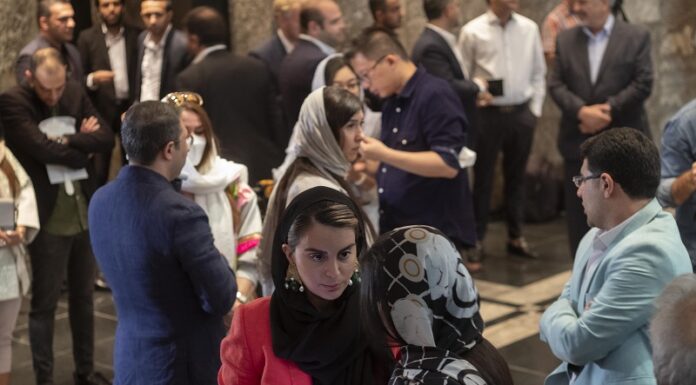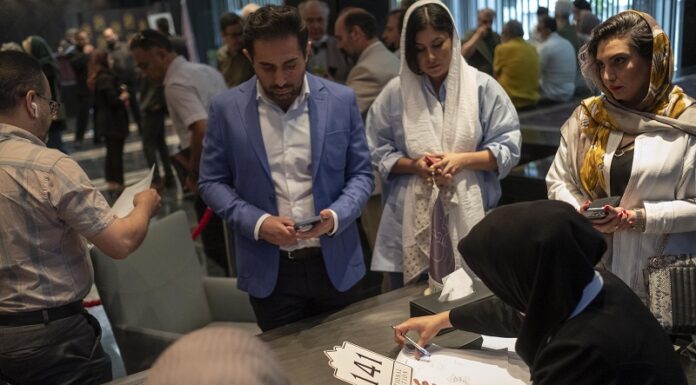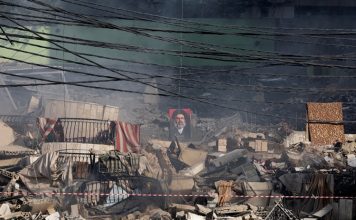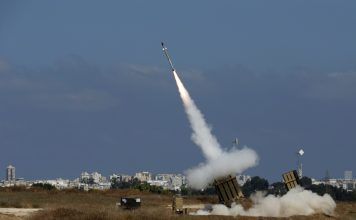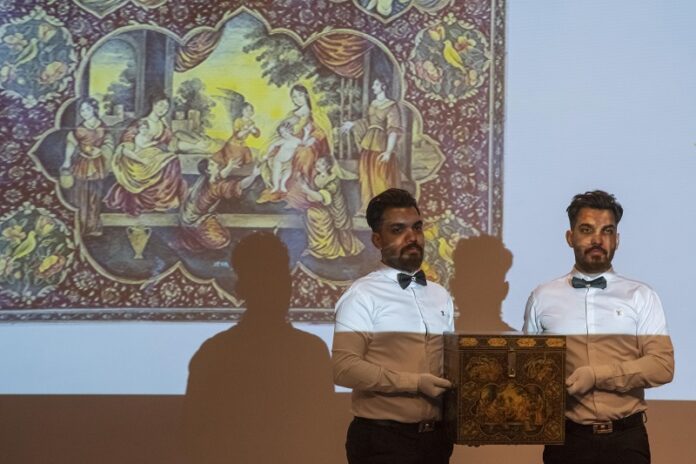
By Kayhan Life Staff
The Iranian Ministry of Cultural Heritage, Tourism and Handicraft (MCTH) has complained about a recent “illegal” art auction held in Tehran, which generated $1.58 million in profit from the sale of ancient Iranian art and antiquities.
The MCTH has warned that the unauthorized sale and transport of ancient artifacts and art objects out of Iran is a “crime.”
“The ministry had not issued a permit for the auction,” a statement released by the MCTH said. “The situation is under investigation.”
The organizers of the seventh Iranian National Auction could face legal problems and even prosecution if objects sold during the auction were to leave the country. The auction has, in the meantime, sparked a public outcry inside and outside Iran.
[aesop_image img=”https://kayhanlife.com/wp-content/uploads/2022/07/2022-06-24T000000Z_275675643_MT1NURPHO000RDDANM_RTRMADP_3_IRAN-POLITICS-1.jpg” panorama=”off” credit=”At the 7th Islamic and Iranian World Art Auction, held by the Melli (National) Auction House at the Conference Center in northern Tehran, employees displayed a historical religious painting by Iranian painter, Ali Ibn Mohammad Ibrahim, in an auction hall on June 24, 2022. REUTERS./” align=”center” lightbox=”on” captionsrc=”custom” captionposition=”left” revealfx=”off” overlay_revealfx=”off”]
Writing on her Telegram channel, Dr. Shirin Ebadi, winner of the 2003 Nobel Peace Prize, said: “Another catastrophic decision by the short-sighted Islamic Republic leaders has led to the sale of the country’s art treasures at the seventh Iranian National Auction.”
“The rare works auctioned included calligraphy pen holders and letter cases belonging to Hossein Behzad, religious paintings attributed to Agha Ebrahim, and a hand-written copy of the Koran. They were sold for $1.58 million,” Dr. Ebadi added.
“What is even sadder than the looting of the country’s irreplaceable cultural heritage is that no one is surprised by the scale and scope of such tragedies occurring in Iran anymore,” Dr. Ebadi said. “We should not expect anything else from a ruling establishment that sells its land and water and puts the safety and security of its citizens at the mercy of a foreign country.”
“It is not a complicated problem,” Dr. Ebadi argued. “Ancient Iranian artifacts have been sold illegally until now. Several Majlis [Iranian Parliament] deputies have floored a proposal that, if passed, legalizes the sale of historical art objects. It means they can continue doing the only thing they are good at more easily.”
Under Article 138 of the Islamic Republic Constitution and Clause 2 of Article 29 of the Civil Service Management Law, only the Ministry of Culture and Islamic Guidance can issue a permit for the sale and auction of historical artifacts and objects as long as they are less than 100 years old and are not part of the country’s “national heritage.”
Under Article 17 of the Historical, Cultural, and Artistic Properties Trade Law, no antiquities or historically significant artefacts can leave the country without the government’s written authorization.
“Authorities must seize all such articles that are exported without a license or permit,” the article says.
Under Article 561 of the Islamic Penal Code, anyone convicted of transporting protected historical artifacts and objects out of the country could be sentenced to one-and-a-half-years in prison, ordered to return the items, and have to pay a fine equivalent to twice the value of the articles “smuggled” out of Iran.
Despite possible legal problems and the MCTH’s stern warning, the seventh Iranian National Auction included many rare pieces from the Zand (1751AD -1794 AD), Qajar (1794 AD -1925 AD), and Timurid (1370 AD -1507 AD) dynasties in its catalogue.
Some art experts have cast doubts over the authenticity of some of the objects sold at the seventh Iranian National Auction held between June 22 and 24 in Tehran. The official report said that some 40 art pieces were sold at the auction, generating $1.58 in profit.
The auction catalogue listed the starting bid for 10 works at $37,000. The highest price listed was for 21 calligraphy pen holders and letter-envelope cases dating back to the Zand Dynasty for $356,000.
The auction also offered an embossed metal plate from the Zand Dynasty for $1,450, a hand-painted calligraphy penholder by Agha Zaman from the Qajar Dynasty for $3,340, and a hand-written copy of the Koran from the Timurid Dynasty for $15,000.
According to the Iranian National Auction, the articles offered for sale during the three-day event included 24 calligraphy penholders and letter-envelope cases from the Qajar dynasty, a miniature painting attributed to the master of modernist Persian miniature painting Hossein Behzad (1894-1968), a religious painting attributed to Agha Ebrahim, a religious painting by Mohammad Ebrahim Naghshbashi (1899-1954), a lacquer painting attributed to Mirza Baba (1795-1830), five painting panels attributed to Ali Khan Saba (1765-1822/23), a wooden door from the workshop of Mirza Agha Emami active during Qajar Dynasty, a hand-written Koran and several textiles.
Shah’s Handwritten Letter Found by Iranian Police in Illegal Antique Shop
The Iranian National Auction was established a decade ago. It held its first public auction in 2016. According to its mission statement, the Iranian National Auction aims to develop the classical Iranian art and handicrafts market and revive the production and export sectors with an emphasis on organizing and holding art exhibitions and auctions.
Hadi Pourjavid is the current director of the National Iranian Auction. The previous directors of the auction included Ali Rouhani and Zahra Mahmoudvand.
Following a formal complaint by the MCTH, the Ministry of Culture and Islamic Guidance refused to take responsibility for allowing the auction to take place. The ministry was quick to point out that it was the job of the MCTH to issue a permit to the auctioneer.
On his personal Instagram channel, Morteza Adibzadeh, the director of Museums and Historical Properties, said: “The MCTH’s Museums and Historical Properties did not issue a permit to the National Iranian Auction. Under Article 561 of the Islamic Penal Code, taking these objects out of the country would be a crime, given their artistic, cultural, and historical significance.”
In an interview with the Iranian Students News Agency (ISNA), Hadi Pourjavid, the current director of the National Iranian Auction, said the auctioneers received a “general permit” from the Ministry of Culture.
“We proceeded under the same legal guidelines and got a permit from the Association of Handicrafts and Antique Objects. We held the auction based on this permit,” ISNA quoted Mr. Pourjavid saying.
Pourjavid said they would release the names of all art and antique experts working for the National Iranian Auction soon.
Getty Villa’s Open-Air Persian Concerts Feature Fared Shafinury, Awardwinning Setar Virtuoso
According to Pourjavid, 40 “Iranian and Islamic” pieces were in the seventh National Iranian Auction, generating $1.58 million in sales for the auction house. Some of those works were included in the auction after being authenticated, appraised, and priced by art and antique experts, Pourjavid explained. Pourjavid said he had met with many art collectors who wanted to sell part of their collections and buy other art pieces.
A recent bill titled “Optimal Use of Ancient Objects and Treasures” is gaining support in the Majlis. It calls for the legalization of the sale and trade of ancient and historical artifacts and objects to compensate for the government’s budget deficit.

